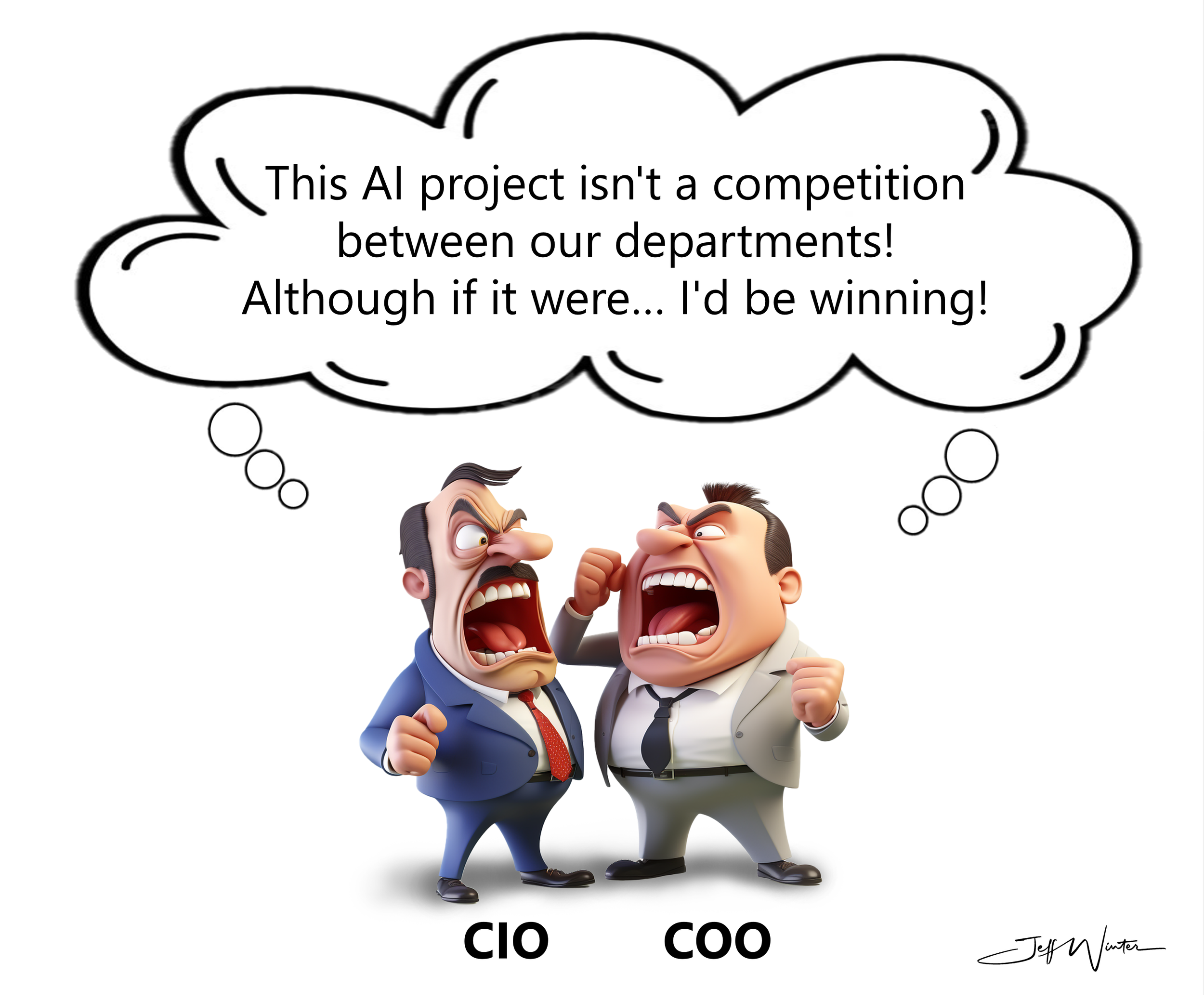When CIOs and COOs Collide: Why AI Is Creating Tension Everywhere
The picture says it all. It perfectly captures the quiet and sometimes not so quiet standoffs happening inside companies as everyone tries to make sense of AI. It is clever, it is relatable, and it highlights an uncomfortable truth. AI is not just another IT initiative or operational improvement. It is a company wide identity shift and everyone feels it.
In 2025, AI has become that rare force that simultaneously reshapes what we do as employees, how departments operate, and how the entire business creates and captures value. Marketing wants AI for speed, finance wants it for forecasting, operations wants it for efficiency, HR wants it for skills, IT wants it for platforms, and leadership wants it for growth. Everyone is sprinting toward their own interpretation of what AI should mean for them while the company is trying to answer the same question at the enterprise level. That parallel scramble creates friction, misalignment, turf battles, and tension, sometimes openly and other times without anyone realizing why progress feels harder than it should.
A core part of the tension comes from the fact that many organizations are “adding AI” without truly changing how work happens. McKinsey’s State of AI 2025 survey notes that only about 21% of organizations using generative AI say they’ve fundamentally redesigned some workflows, rather than just layering AI on top of existing processes. That gap is where the CIO–COO conflict lives: the CIO can declare “platform success” while the COO still sees the same bottlenecks, same hand‑offs, same KPIs. On paper, AI is “in production.” In reality, the work hasn’t truly changed, so the value doesn’t show up.
At the same time, AI is bubbling up from the bottom. Employees aren’t waiting for pristine roadmaps; they’re grabbing whatever helps them move faster. BCG’s AI at Work 2025 study found that 54% of employees openly admit they would use AI tools even without company authorization. That means your “official” AI strategy and your real AI usage pattern may be living in different universes.
Put those two stats together and you get the modern AI landscape: leadership says “AI is strategic,” departments jostle for their slice, IT tries to standardize, operations tries to hit the numbers, and employees quietly route around whatever doesn’t help them today. No wonder the CIO and COO feel like they’re in a cage match. AI isn’t “owned” by any one team; it’s now everyone’s concern, and that makes coordination way harder than the last generation of tech rollouts.
Shortcut Truce Plan
AI has created a strange moment inside companies. Every team is experimenting, every leader is making new claims, and every workflow is suddenly up for reconsideration. Some departments see AI as a chance to move faster. Others see it as a threat to the way things currently work. Leaders feel pressure to show progress while employees want clarity about how their roles will evolve. All of this creates a natural pull in different directions. It is not dysfunction. It is the reality of introducing a technology that affects the entire organization at once.
This is why the truce between CIO and COO matters. Not because they are the only owners of AI, but because the work of both roles touches every corner of the company. When they align on what good looks like and how AI shows up in daily work, everyone else has a clearer path forward. The truce is not about who controls the technology or who controls the operations. It is about creating a shared rhythm that keeps the company moving in one direction. Here is a practical plan to make that happen.
Create one shared scoreboard.
Identify a short list of outcomes that define success for the entire company such as time to value, workflow adoption, improvements in core operational metrics, reliability in production, and the continued health of AI systems. Make both leaders equally accountable for the same set of results.
Begin with the work, not the model.
Start every AI effort by defining how the work will change. Identify the steps that will be replaced or improved and who will operate differently as a result. A clear workflow shift is the strongest predictor of real value.Build AI as a set of products.
Create durable products like internal assistants, predictive quality tools, or planning intelligence suites. Give each product a roadmap, a backlog, and shared ownership from technology and operations.Provide a strong foundation and let each team adapt it.
The CIO should deliver clean data, security, monitoring, and governance. The COO and operational teams should shape how the capabilities fit into daily routines, training, and performance expectations.Integrate governance from the beginning.
Make testing, monitoring, and fallback procedures part of the delivery process. Strong guardrails increase trust and prevent the slow erosion of progress after launch.Bring unofficial AI use into the conversation.
Ask teams what tools they are already using and why those tools help them. Use their insights to guide official offerings instead of fighting hidden usage.Keep AI present in role and career discussions.
Invite employees to express what AI could take off their plate and what new responsibilities they are ready to step into. This builds confidence, clarity, and genuine engagement.
References:
Singla, A., Sukharevsky, A., Yee, L., & Chui, M. (2025, March 12). The state of AI: How organizations are rewiring to capture value. McKinsey & Company. https://www.mckinsey.com/capabilities/quantumblack/our-insights/the-state-of-ai
Beauchene, V., Duranton, S., Kalra, N., & Martin, D. (2025, June 26). AI at Work: Momentum Builds, but Gaps Remain. Boston Consulting Group. https://www.bcg.com/publications/2025/ai-at-work-momentum-builds-but-gaps-remain

